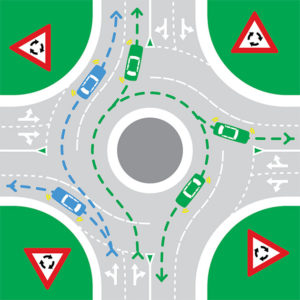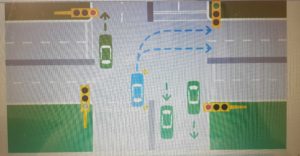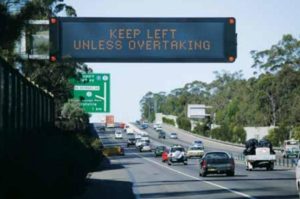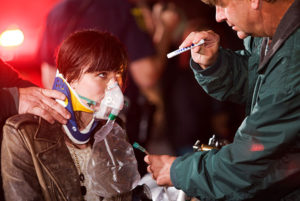After my first lesson, I was confident to go for the test, and I PASSED ON MY FIRST GO, with a score of 103/106.
NSW – Supervising A Learner Driver
While many learner drivers take lessons from professional driving instructors, many will also want additional driving practice and some guidance from a parent, relative or friend. This page provides information for people supervising learners.
Supervising driver requirements
To supervise a learner, you must
- Hold a current full Australian driver licence – not a learner or provisional licence
- Have a good understanding of the road rules
- Be a competent driver
- Be able to effectively communicate information and ideas clearly.
Blood alcohol limit
The blood alcohol content (BAC) limit for you while you are supervising a learner is under 0.05. It is also illegal to supervise under the influence of drugs.
Learner driver log book and digital log book apps
Learner drivers need to record their practical experience in a log book. They can choose to use either a paper log book, or a digital log book app.
As the supervising driver, you’ll need to mark off the learner’s progress against a range of key tasks listed in their log book. Both the book and app include instructions on how to do this.
Remember, you are a role model
You are both a role model and mentor for your learner driver. You should support and help them become a safe and skilled driver. You also need to be patient and calm.
It is a good idea to review your own driving habits by:
- Reading the Road Users Handbook to familiarise yourself with current road rules
- Making sure you comply at all times with traffic lights, signs and road markings
- Leaving plenty of space between your vehicle and the vehicle in front
- Looking well ahead and checking ‘blind spots’ and vision blockouts
- Driving at a suitable speed for conditions
- Responding appropriately to hazards
- Being patient and courteous with other drivers
- Reading the Learner Driver Log Book to understand the content and learning goals.
12 tips for better learner supervision
When you’re supervising your learner driver:
- If either you or the learner driver is tired, upset or stressed, reschedule the practice session to another time
- Try frequent, short practice sessions in the beginning
- Use the Learner Driver Log Book task key points as a guide to practice sessions
- Begin with the easiest tasks then, once your learner has mastered those, move on to more difficult tasks
- Discuss then demonstrate new tasks before asking your learner to attempt them
- Use ‘commentary driving’ – talk about what is happening inside and outside the vehicle
- Start the learner practising on quiet streets, preferably in daylight, before moving onto busier roads and more challenging conditions
- Allow the learner to proceed at their own pace – don’t force them to attempt tasks they’re not ready for
- Don’t criticise mistakes. Calmly explain and discuss what happened and allow the learner to try again
- Be positive and offer praise when the learner successfully completes a task
- Emphasise the importance of developing a sensitivity to speed. Learners need to understand that the faster a vehicle travels, the more difficult it is to respond to potential hazards. When involved in a crash, the faster a vehicle is travelling, the more devastating the outcome
- Avoid using the radio, mobile phone or talking to other passengers while your learner is practising.
Free workshops – helping learner drivers become safer drivers
Free workshops for parents and supervisors of learner drivers are conducted around NSW. The workshops offer practical advice on how to help learner drivers become safer drivers, and cover topics such as:
- How to use the Learner Driver Log Book
- Planning driving sessions
- How to deal with difficulties that may arise during driving practice
- The importance of giving your learner constructive feedback.
For information about workshops in your area, call us on 13 22 13.
NSW Variable Message Signs
Variable message signs
Variable Message Signs are large electronic signs placed on the side of some roads.
They display messages to warn motorists of changes in normal traffic conditions on the road ahead, such as fog, crashes, road works, congestion and road closures.
These early warnings help provide a safe and efficient traffic flow.
NSW – Red Light Speed Cameras
Red light speed cameras
Red light cameras are used to photograph vehicles that go through a red light.
A penalty notice is then sent to the owner of the vehicle, who has the option to:
- Pay the fine.
- Advise Revenue NSW on a statutory declaration the name and address of the person driving at the time of the offence.
- Advise Revenue NSW you want to have the case heard by a court.
If you are crossing the intersection as the light turns yellow (amber) and it is not safe to stop, do not panic. Continue driving through the intersection. The camera only takes a photograph if you cross over the stop line 0.3 seconds after the light has turned red.
Traffic already in the intersection or entering on a yellow (amber) light will not activate the red light camera.
Red light speed cameras use digital technology that is capable of detecting both red-light and speeding offences.
Signs At Traffic Lights
 A STOP sign with three black dots is only seen at traffic lights. It means that if the lights are not working or are flashing yellow and you are approaching this sign, you must stop and give way to traffic as though you are at an intersection with stop signs.
A STOP sign with three black dots is only seen at traffic lights. It means that if the lights are not working or are flashing yellow and you are approaching this sign, you must stop and give way to traffic as though you are at an intersection with stop signs.
This sign allows you to turn left on a red light after stopping. When turning left you must give way to all traffic approaching from the right.
Left turn on red light is only permitted at intersections where the sign has been placed.
NSW – Traffic Lights
Red means stop. Wait behind the stop line.
Do not go through the intersection.
Yellow (amber) means stop. You can enter the intersection if you are so close that sudden braking might cause a crash.
Green means proceed through the intersection carefully.
Turning arrows at traffic lights
Some traffic lights have arrows to control traffic turning right or left.
A green arrow means you can only turn in that direction.
A red arrow means traffic waiting to turn must wait behind the stop line until the arrow turns green or disappears, even if there is no traffic on the road.
You must not go straight ahead or turn left. You may turn right.
You must not turn right but you can go straight ahead or turn left if the way is clear.
When the yellow (amber) arrow is flashing, you may proceed but you must give way to any pedestrian who is crossing the road into which you are turning.
NSW Roundabouts- If practical, you must always signal left when exiting
If practical, you must always signal left when exiting a roundabout.

Making turns and giving way at roundabouts
The diagram shows how to indicate and give way at roundabouts:
- Approaching a roundabout: Vehicles entering a roundabout must give way to any vehicle already in the roundabout.
- Giving way at a roundabout: The driver must slow down and if necessary, stop to avoid a collision.
- Turning left: On your approach to a roundabout you must select the left lane, signal left, stay in the left lane to exit.
- Going straight ahead: Do not signal when approaching the roundabout but always signal left before exiting a roundabout. You may approach the roundabout from either left or right lanes (unless there are road markings with other instructions), drive in the same lane through the roundabout and exit in the same lane.
- Turning right: On your approach, to a roundabout you must select the right lane, signal right, stay in the right lane and signal left before exiting into the right lane.
- Making a U-turn: When you use the roundabout to make a U-turn on your approach signal right from the right lane, stay in the right lane, but signal left before exiting into the right lane.
- Exiting a roundabout: If practical, you must always signal left when exiting a roundabout.
Roundabouts and bicycle riders
Bicycle riders are allowed to turn right from the left hand lane. When passing each exit, the rider must give way to any vehicle leaving the roundabout from that exit.
Risks to watch for
Take extra care whenever you drive in a roundabout:
- Keep an eye out for cars that are leaving the roundabout
- Be careful if changing lanes in a roundabout, particularly when leaving
- Look out for vehicles that are making a full turn
- Watch for bicycles, long vehicles and motorcycles.
NSW U-Turns
U-Turns
Take extra care when making U-turns as they can be dangerous. U-turns
cannot be made:
• Where there is a NO U-TURN sign
• On motorways
• At traffic lights unless you see a U-TURN PERMITTED sign at the
intersection
• Across an unbroken (continuous) lines, double centre unbroken
(continuous) lines, unless the line closest to you is broken.
You must start your U-turn from the marked lane nearest to the centre of
the road or, if there are no lane markings, the left of the centre of the road.
Before starting the U-turn you must make sure it is safe: check mirrors
and blind spots and that you have a clear view of any approaching
traffic.
You must not begin your U-turn unless you can make the turn without
unreasonably obstructing traffic. Give way to all vehicles and pedestrians
and signal before you start to turn.
NSW When Turning Right At Traffic Lights
When turning right at traffic lights:
• Enter the intersection as shown in the diagram, unless a sign indicates
otherwise or there is a red right turn arrow displayed
• Wait until oncoming traffic clears or breaks and then turn safely.
If the lights change to yellow or red while you are in the middle of the
intersection, you are allowed to turn right. You must turn as soon as it
is safe to do so. Be sure your front wheels and car are straight and not
blocking the oncoming traffic.

Car A enters the intersection.
Speeding in NSW
Even though the NSW road toll has dropped from more than 1200 each year in the 1970s to less than 500 (based on the 2008 road toll and the preliminary figures for 2009), speeding remains an ongoing problem.
In the 1970s and early 1980s, drink driving was Australia’s biggest road safety challenge. However since random breath testing was introduced in 1982 there has been a change in community opinion – drink driving is not acceptable. If we can all adopt this attitude to speeding as well our roads will be a much safer place.
With the decrease in drink driving, speed has become the biggest road safety challenge for NSW.
The size of the problem
In NSW speeding is a factor in about 40 per cent of road deaths. This means on average around 177 people die each year in speed-related crashes in NSW.
Speeding was a factor in the deaths of 857 people over five years 2006-2010. In addition to those killed, more than 4100 people are injured in speed-related crashes every year.
Did you know each year around 700,000 speeding offences are recorded in NSW?
Risky business
It’s not that hard to work out that speeding increases the risk of a crash and the severity of the crash outcome.
The risk of causing death or injury in an urban 60km/h speed zone increases rapidly even with relatively small increases in speed. If you are driving are 65km/h in a 60km/h speed zone you are doubling your chances of having a crash. At 70km/h, your risk of having a crash is more than four times the risk at 60km/h.
| SPEED – KM/H | RISK RELATIVE TO 60KM/H |
|---|---|
| 65 | Double |
| 70 | 4 times |
| 75 | 11 times |
| 80 | 32 times |
The risk of a crash when driving at 68km/h in a 60km/h zone is the same as driving with a blood alcohol level of 0.08. The risk of a crash when driving at 72km/h in a 60km/h zone is the same as driving with a blood alcohol level of 0.12.
A key issue in speeding-related crashes is that most motorists underestimate the distance needed to stop. A car travelling at 60km/h in dry conditions takes about 38 metres to stop. A car travelling at 80km/h needs an extra 20 metres.
The message is simple ‘Don’t Rush’
In order to help raise awareness of the issue surrounding speeding Roads and Maritime Services launched the road safety speeding campaign ‘Don’t Rush’. The campaign focuses around the need to reinforce the crash consequences of speeding, and to contribute to an overall reduction in the road toll. It is important that communities are conscious of the emotional and physical impact on others road trauma has. Therefore the ‘Don’t Rush’ campaign also focuses on encouraging community caution amongst peers in speaking out against other in their peer group who don’t stick to the road rules.
Males in particular are the campaigns primary focus, as they are over represented in speed-related crashes in NSW.
You can see the ‘Don’t Rush’ messages from Professor Owler and Testimonials spoken by real life crash survivors and their families on the Centre for Road Safety website.









